Seattle has always been a city of contrasts. Surrounding waters reflect the mountains. Glass towers climb above streets lined with century-old brick. Technology thrives where timber once ruled. That juxtaposition is evident at Populus Seattle, a new hotel that introduces nature to Pioneer Square, while giving new life to one of the neighborhood’s oldest landmarks.
The property is the second opening from Populus Hotels, the carbon-positive collection created by Urban Villages. Like its Denver sibling, Populus Seattle is as much a statement of environmental intent as it is a welcoming and cozy place to stay. But here, in the heart of Seattle’s first neighborhood, the hotel’s message is amplified by history.
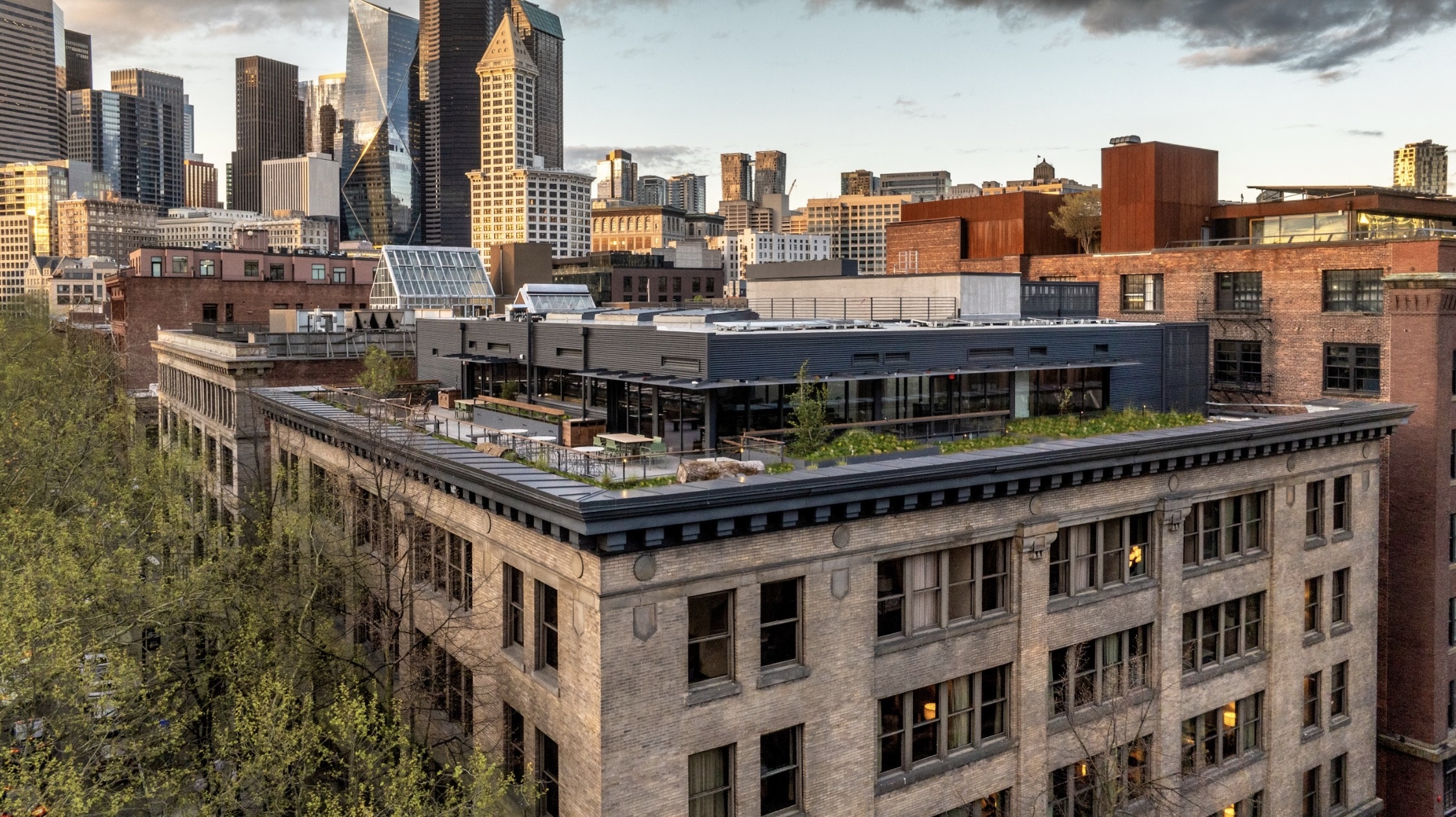
A Landmark Reimagined
The building began its life in 1907 as the Westland Building, part of a wave of early-20th-century construction that reshaped Pioneer Square after the Great Fire. Rather than replace the structure, Populus embraced adaptive reuse, choosing to preserve and reinterpret its original framework. Douglas Fir beams, car decking, and exposed brick remain intact, giving the hotel a patina that only time can create. In some places, the architects went further, restoring elements that had been obscured in later decades. A skylight, once covered, now stretches from the lobby through the roofline, funneling natural light across multiple floors and reestablishing a connection to the outdoors.
The choice to reuse instead of rebuild was not merely aesthetic. By avoiding new construction, Populus Seattle cut its embodied carbon footprint by more than a third. That decision dovetails with the brand’s larger sustainability mission: to open hotels that sequester more carbon than they emit.
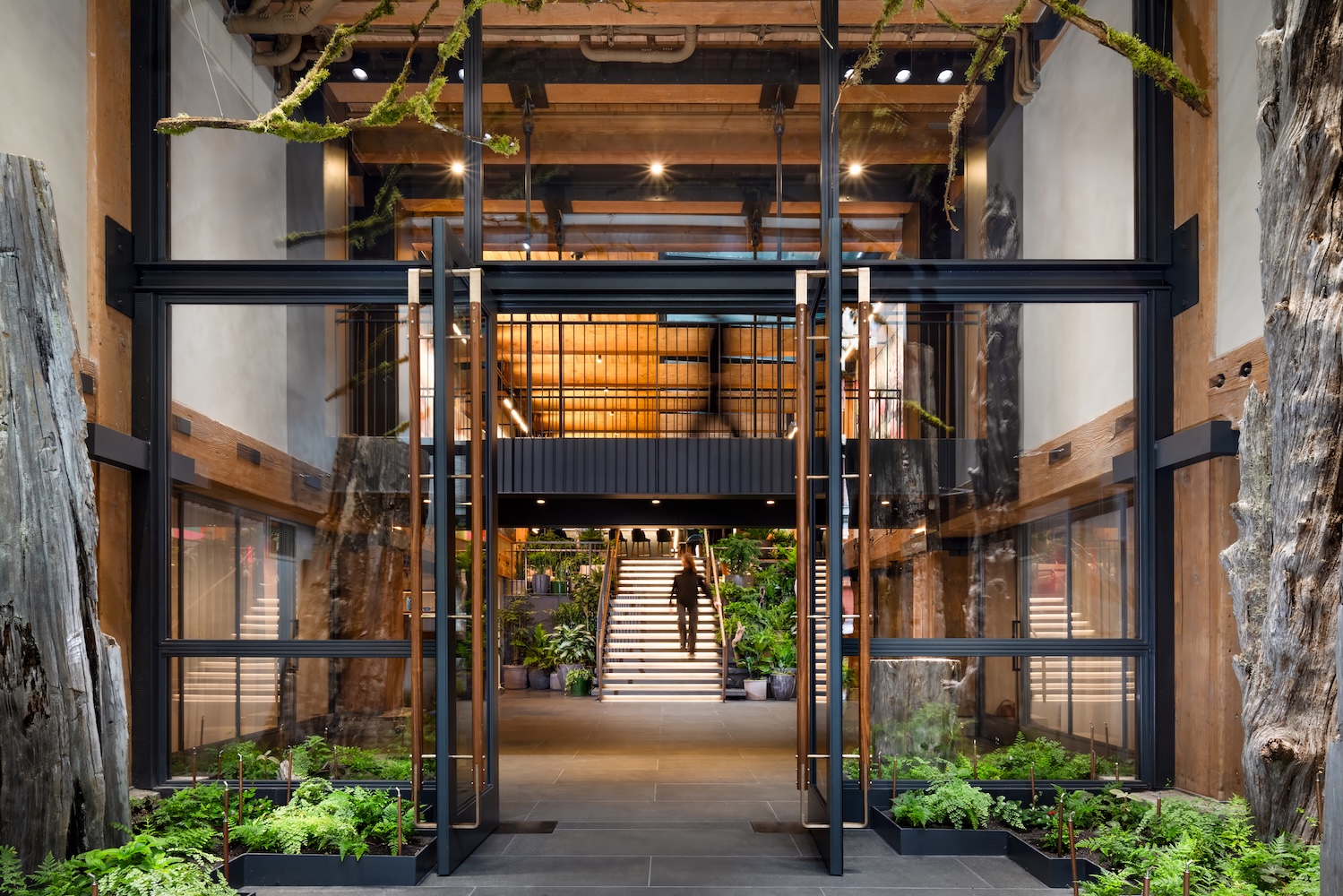
A Forest Within
Both outside and in, the building’s history is preserved, but the interiors carry an added layer of transformation. Chicago-based design studio Curioso took cues from the Pacific Northwest rainforest, creating spaces of raw wood and forged steel that are both nature-based and urban. Within the entry, guests are greeted not with conventional sculpture, but with G(host) Forest, a massive installation by Isvald Klingels composed of fallen trees, branches, and living plants. Suspended in the vestibule, it acts as both art and ecosystem, a reminder of the old-growth forests that once defined this part of the city. (And if you look closely, you might spot the resident frog that frolics within the foliage.)
Greenery continues throughout: a multi-story moss wall climbs toward the skylight, tropical plants frame the lobby staircase, and the Salt Harvest Solarium envelops diners in glass and hanging potted plants, evoking the filtered light of a rainforest canopy. On the rooftop, prairie plantings designed by Seattle-based Site Workshop attract hummingbirds and bees, restoring small but vital habitats in the middle of the city.
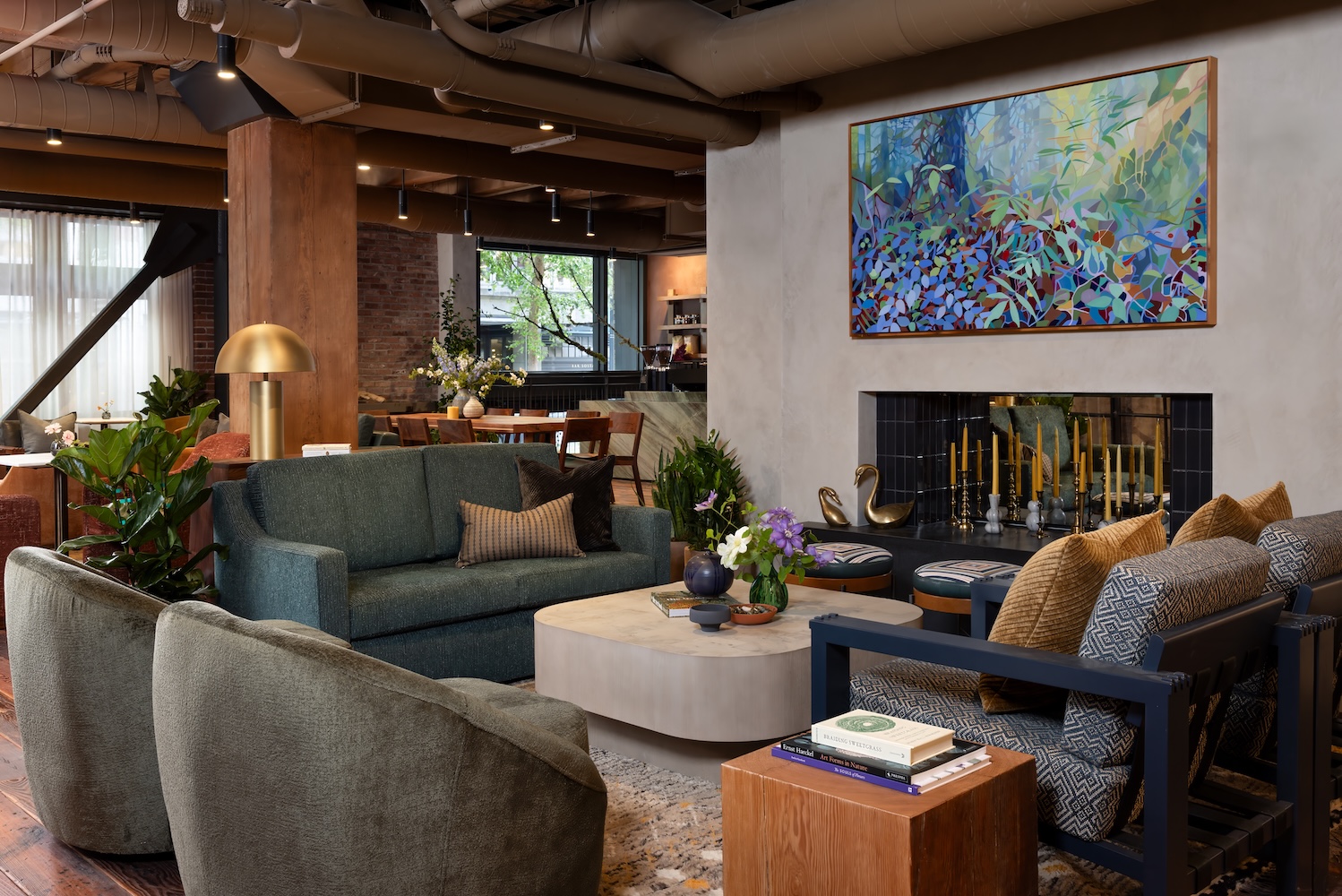
Art Anchored in the Northwest
Populus Seattle’s art program rivals its architecture in ambition. More than 300 works, curated with ARTXIV, showcase a revival of regional voices alongside international perspectives. (Many are for sale; if you see one that strikes a chord, it could be yours.) Murals and large-scale pieces by artists such as Sean Barton, Andrea Heimer, and Joe Feddersen anchor the lobby and public spaces, telling stories of the Pacific Northwest’s landscapes and cultures. Like the forest installations, the art is not an afterthought. It is integrated into the experience of the hotel, part of the dialogue between past and present, city and wilderness.

Rooms That Reflect the Landscape
The hotel’s 120 guest rooms feature exposed brick walls meet contemporary furnishings. Oversized windows pull daylight deep into the richly-hued interiors. Room categories nod to regional flora, as do the hand painted botanical artworks on every guest room door: the Lupine King Room offers simple, light-filled comfort, while the Noble Fir Studio King adds a lounge area and soaking tub. At the top, the Summit Suite extends into a private terrace overlooking the city. It’s an urban aerie softened by natural materials and greenery. These are not merely places to rest between meetings or excursions. They are designed as elevated retreats, grounded in a sense of Seattle’s natural environment.
A Culinary Identity Rooted in Place
If the architecture honors history and the interiors recall the forest, the hotel’s culinary program captures the flavors of the Pacific Northwest. Salt Harvest, the signature restaurant, is anchored by a wood-fired hearth. Chefs Conny Andersson and Jonathan De Paz draw on a pedigree that includes the Four Seasons, Six Senses, The French Laundry, and Eleven Madison Park. Their cooking is ingredient-driven, inspired by the land and sea that define Seattle’s geography. Expect oysters kissed by smoke, vegetables pulled from local farms, and meats prepared with a simplicity that highlights their quality. The restaurant offers multiple experiences: a lively bar, intimate private dining rooms, and a set-menu Chef’s Counter where guests have a front row seat for the kitchen choreography. The Solarium, with its glass walls and abundant greenery, transforms a meal into something immersive. It’s like dining within a forest without ever leaving the city.

For morning rituals, The Café at Salt Harvest serves hyper-local Monorail coffee and pastries and is favored by both guests and locals. An alley entrance encourages commuters to weave the hotel into their daily routines. And the hotel’s crowning glory is Firn, Pioneer Square’s first rooftop bar where the city views are stunning. Named for the compacted snow that forms glacial ice, the bar pays homage to the mountains that frame Seattle’s skyline. Here, creatively crafted cocktails are fittingly organized by ice type—clear, crushed, or block.
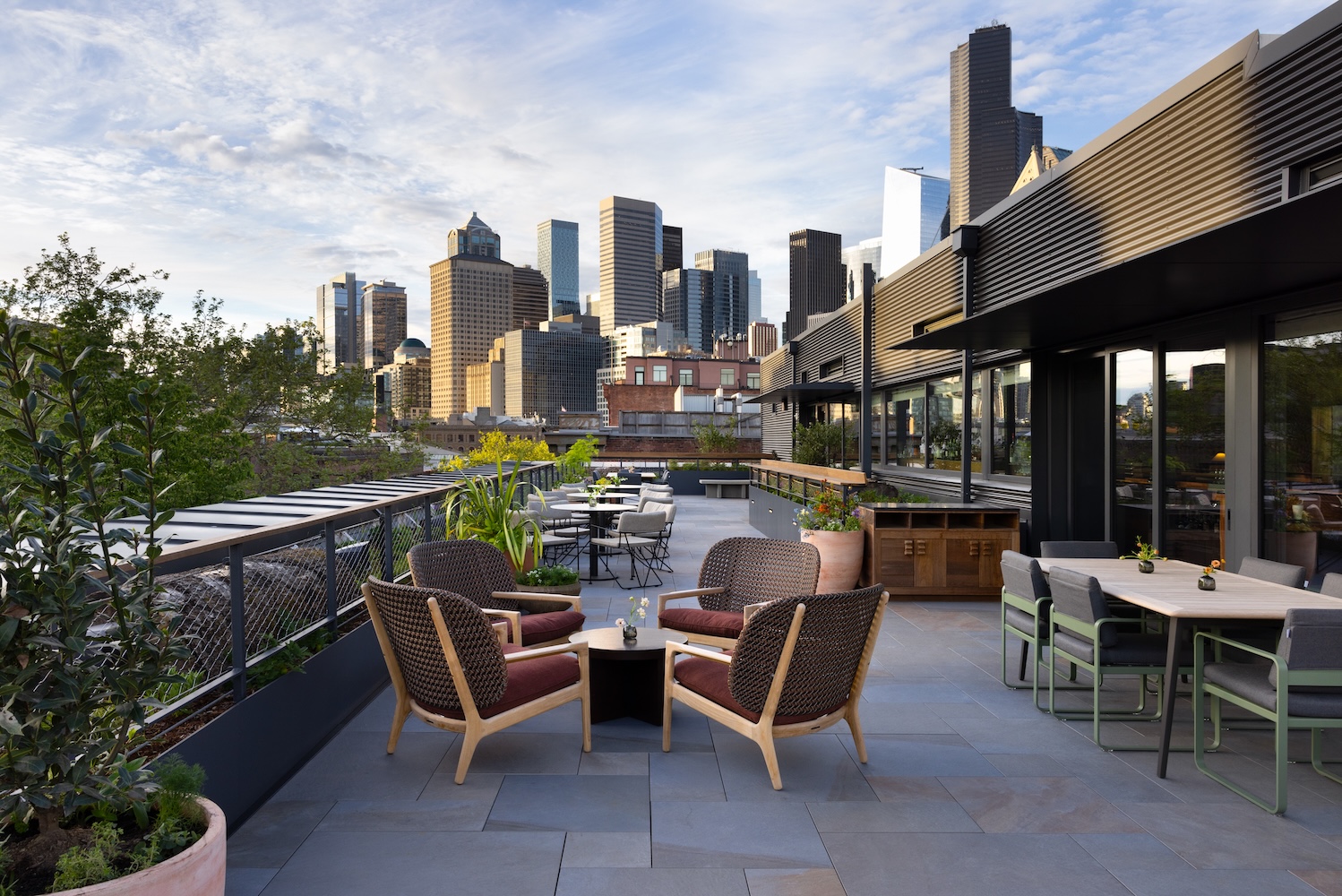
Community at the Core
Populus Seattle was not designed as an isolated enclave. The hotel opens directly onto RailSpur, the emerging micro-district developed by Urban Villages that weaves together historic buildings and reimagined alleyways into an anticipated hub for art, community, and cuisine, with several anticipated culinary concepts helmed by James Beard Award–winning restaurateur Renee Erickson, whose many local restaurants celebrate the Pacific Northwest’s bounty. Within the hotel, that communal ethos plays out in spaces like the cozy Library (where you’ll find complimentary morning coffee) and the Art Room, which hosts both community and private events. Together, these spaces reinforce the idea that the hotel is not only a place to stay, it’s a gathering spot, central to Pioneer Square’s cultural life.
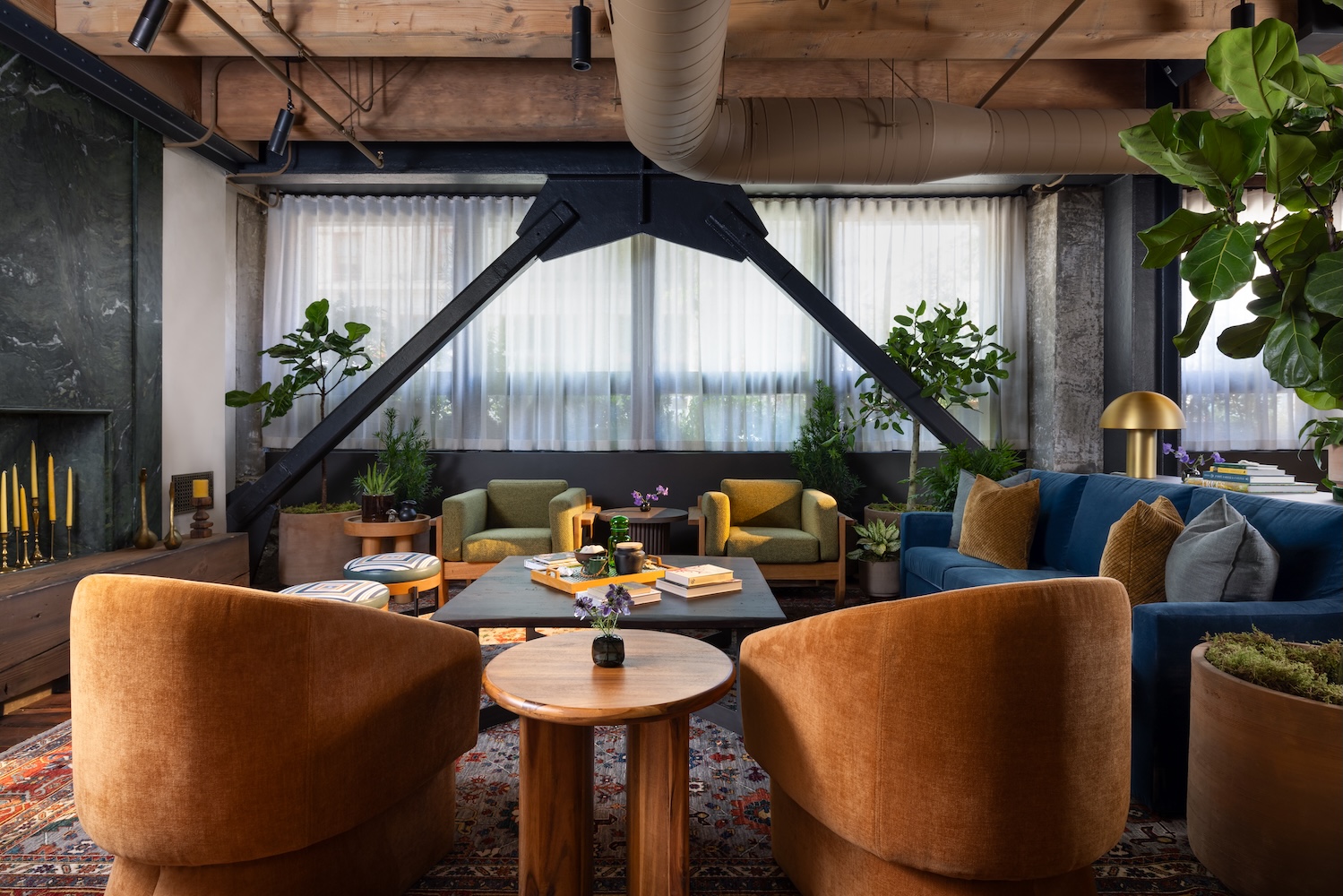
Sustainability Beyond the Surface
Many hotels claim eco-consciousness; few pursue it with the rigor of Populus. Every detail of the Seattle project has been measured through a Life Cycle Assessment, evaluating impact from construction through decommissioning. The property partners with King County’s Forest Carbon Program to support conservation and parks. Electricity is 100% renewable. Food waste is composted. Most visibly, the One Night, One Tree initiative plants a tree for every night booked, a program launched in Denver and continued here. Such measures are stealth and from the heart, and not at all performative. The numbers are as striking as the design: a 36% reduction in embodied carbon, the equivalent of 2.2 million miles not driven. But the broader impact is philosophical—hospitality reframed not as consumption, but as contribution.
A New Chapter for Pioneer Square
Populus Seattle is more than a boutique hotel. It is an inflection point for Pioneer Square, a neighborhood that once defined the city’s identity and is now poised for renewal. With the arrival of RailSpur, the area is becoming a cultural and culinary hub again.
In that context, Populus serves as both anchor and amplifier: a hotel that reflects the city’s history while aligning with its environmental future. Guests may come for the location, the art, or the rooftop cocktails. They will leave with the sense that they have stayed in a place deeply connected to its setting, where city and forest coexist, and where history is not erased, but allowed to grow a second life.
Photos by Ric Stovall, courtesy of Populus Seattle, unless otherwise noted
